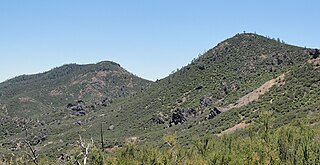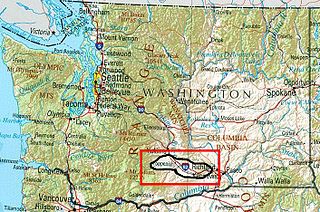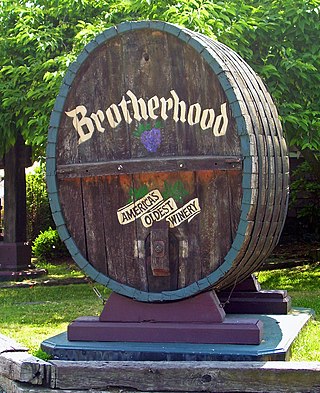
An American Viticultural Area (AVA) is a designated wine grape-growing region in the United States, providing an official appellation for the mutual benefit of wineries and consumers. Winemakers frequently want their consumers to know about the geographic pedigree of their wines, as wines from a particular area can possess distinctive characteristics. Consumers often seek out wines from specific AVAs, and certain wines of particular pedigrees can claim premium prices and loyal customers. If a wine is labeled with an AVA, at least 85% of the grapes that make up the wine must have been grown in the AVA, and the wine must be fully finished within the state where the AVA is located.

Carmel Valley is an American Viticultural Area (AVA) located in Monterey County, California, southeast of Carmel-by-the-Sea and it is one of the ten AVAs in the county. Approximately 100 miles (161 km) south of San Francisco, the AVA was recognized by the Bureau of Alcohol, Tobacco and Firearms (ATF), Treasury on January 13, 1983 after reviewing the petition submitted by Mr. David Armanasco, General Manager of Durney Vineyard, located in Carmel, to propose a viticultural area named “Carmel Valley.”

Chalone identifies the first American Viticultural Area (AVA) established in Monterey County, California straddling its border with San Benito County where it is the second established AVA. Chalone viticultural area is located in the Gabilan Mountains east of Soledad. It was recognized by the Bureau of Alcohol, Tobacco and Firearms (ATF) effective on July 14, 1982 after reviewing the petition submitted by the Gavilan Vineyards, Inc. to establish a viticultural area in Monterey and San Benito counties to be named "The Pinnacles." The area encompasses 8,640 acres (14 sq mi) and the proposed name was recognition of the nearby Chalone peaks.

Washington wine is a wine produced from grape varieties grown in the U.S. state of Washington. Washington ranks second in the United States in the production of wine. By 2017, the state had over 55,000 acres (220 km2) of vineyards, a harvest of 229,000 short tons (208,000 t) of grapes, and exports going to over 40 countries around the world from the 940+ wineries located in the state. While there are some viticultural activities in the cooler, wetter western half of the state, the majority (99.9%) of wine grape production takes place in the shrub-steppe eastern half. The rain shadow of the Cascade Range leaves the Columbia River Basin with around 8 inches (200 mm) of annual rain fall, making irrigation and water rights of paramount interest to the Washington wine industry. Viticulture in the state is also influenced by long sunlight hours and consistent temperatures.

Yakima Valley is the first American Viticultural Area (AVA) established within Washington state, gaining the recognition on May 4, 1983. Within the vast Columbia Valley AVA, Yakima Valley appellation cultivates more than 53,000 acres (21,448 ha) giving the region the largest concentration of wineries and vineyards in the state. The most widely planted varietals in the area are Chardonnay, Riesling, Merlot, Cabernet Sauvignon, Pinot gris, and Syrah. Nearly 40% of Washington's annual wine production is made from Yakima Valley grapes. In addition to grapes, the Yakima Valley is also home to several fruit orchards growing apples, cherries, nectarines, peaches, pears and plums. Around the town of Zillah, there is the Zillah Fruit Loop driving tour through the area's orchards and vineyards. The area is also home to nearly 80% of the US hop production.

Puget Sound is an American Viticultural Area (AVA) in northwest portion of Washington state encompassing Clallam, Island, Jefferson, King, Kitsap, Mason, Pierce, San Juan, Skagit, Snohomish, Thurston and Whatcom Counties. It is the only Washington AVA located west of the Cascade Mountains.

Santa Clara Valley is an American Viticultural Area (AVA) located mostly in Santa Clara County, California. The area served an important role in the early history of California wine and was home to the pioneer winemakers Paul Masson and Charles Lefranc. It was established on April 27, 1989 by the Bureau of Alcohol, Tobacco and Firearms (ATF), Treasury after evaluating the petition proposing a viticultural area in Santa Clara, San Benito, San Mateo and Alameda Counties that extends from lower San Francisco Bay with the cities of San Jose, Santa Clara, Menlo Park, Mountain View and Fremont toward the southern boundary near Gilroy and Morgan Hill, outlining the viticultural area named "Santa Clara Valley." It includes the historic winegrowing areas of Santa Clara County not already within the [Santa Cruz Mountains viticultural area, plus the area near Mission San José in Alameda County and a small part of San Benito County. Santa Clara Valley encompasses the established viticultural areas, Pacheco Pass and San Ysidro District.

The history of American wine began when the first Europeans explored parts of North America, which they called Vinland because of the profusion of grape vines found there. However, European settlers, namely the Spanish, would later discover that the wine made from the various native grapes, had flavors which were unfamiliar and which they did not like. This led to repeated efforts to grow familiar Vitis vinifera varieties. The first vines of Vitis vinifera origin came up through New Spain (Mexico) and were planted in Senecu in 1629, which is near the present day town of San Antonio, New Mexico.

Sierra Foothills is a vast American Viticultural Area (AVA) encompassing the foothill "belt" of the Sierra Nevada in north-central California, United States. It was established on December 18, 1987 by the Bureau of Alcohol, Tobacco and Firearms (ATF), Treasury after evaluating the petition filed by the Sierra Foothills Winery Association of Somerset, California for the establishment of a "Sierra Foothills" viticultural area in portions of Yuba, Nevada, Placer, El Dorado, Amador, Calaveras, Tuolumne and Mariposa Counties. Wine grapes were introduced to the area in the nineteenth century during the California Gold Rush. Over 280 vineyards/wineries are located within its boundaries.
The Chiles Valley is an American Viticultural Area (AVA) located in Napa County, California and a sub-region within Napa Valley AVA. It was established as California's 81st AVA by the Bureau of Alcohol, Tobacco and Firearms (ATF) on April 19, 1999 after the ATF received the petition from Mr. Volker Eisele, owner of the Volker Eisele Vineyard and Winery proposing a new viticultural area in Napa County to be known as "Chiles Valley District".

Edna Valley is an American Viticultural Area (AVA) located in San Luis Obispo (SLO) County, California encompassing the rural town of Edna which is 9 miles (14 km) southeast of the county seat San Luis Obispo and north of the small coastal town Arroyo Grande. It was established by the Bureau of Alcohol, Tobacco and Firearms (ATF) as the county's first AVA within California’s multi-county Central Coast AVA effective May 12, 1982. It became an sub-appellation of the county’s newest San Luis Obispo Coast viticultural area since April 2022. The valley is diagonally flanked by Lake Lopez to the south and Islay Hill to the north. The elongated valley extends along a northwest-southeast axis bordered to the west by the Santa Lucia Mountains and surrounded by volcanic mountains and characterized by black humus and clay-rich soils. With moderate sunshine, cool maritime fog, and rich oceanic and volcanic soils, the Edna Valley appellation has California's longest growing season. The valley is kept cool by breezes from the Pacific Ocean and morning fog. The extended growing season allows complex flavors to develop in the grapes.

Colorado wine refers to wine made from grapes grown in the U.S. state of Colorado. Most of Colorado's vineyards are located on the western slope of the Rocky Mountains, though an increasing number of wineries are located along the Front Range.

El Dorado is an American Viticultural Area (AVA) located in El Dorado County, California, east of the state’s capital, Sacramento and centered around the county seat of Placerville. It was established on November 14, 1983 by the Bureau of Alcohol, Tobacco, Firearms and Explosives (ATF), Treasury after approving the submitted petition from the El Dorado Wine Grape Growers Association of Camino, California applying to establish a viticultural area named "El Dorado.” The area includes parts of El Dorado County on the north border by the Middle Fork American River and on the south by the South Fork of the Cosumnes River. El Dorado viticultural area lies within the vast 4,062 square miles Sierra Foothills viticultural area, one of the largest appellations in California, which extends about 170 miles (274 km) through portions of Yuba, Nevada, Placer, El Dorado, Amador, Calaveras, Tuolumne and Mariposa Counties. The El Dorado viticultural area encompasses 1,093,120 acres (1,708 sq mi) which entirely includes Fair Play and a small portion of northeastern California Shenandoah Valley AVAs.

Fiddletown is an American Viticultural Area (AVA) in Amador County, California, United States. The area was established on November 3, 1983 by the Bureau of Alcohol, Tobacco and Firearms (ATF), Treasury after reviewing the petition submitted from the Fiddletown Wine Grape Growers in Amador County to establish a viticultural area to be known as "Fiddletown." The region was first settled in 1849, during the California Gold Rush. Settlers who stayed in the area eventually planted grape vines, which became abundant by the end of the nineteenth century. Most of the vineyards in the Fiddletown AVA are located in the south and west portion of the region on Sierra Nevada slopes between 1,500 to 2,500 feet (457–762 m) above sea level. About 20% of the wine produced in Amador County comes from Fiddletown viticultural area.
The Cienega Valley AVA is an American Viticultural Area located in western San Benito County, California, United States. It is part of the larger Central Coast AVA. The valley was once a major source of wine grapes for Almaden Vineyards before it was acquired by Constellation Brands in 1987. Approximately 1,100 feet (340 m) above sea level, the valley floor is divided by the San Andreas fault. Soil on the east side of the fault is predominantly granite and sandstone, whereas soils on the west side of the fault are predominantly granite and limestone. It contains some of the oldest pinot noir grapes in California.
Pacheco Pass is an American Viticultural Area (AVA) located in the Santa Clara and San Benito counties of California. It lies within the larger San Francisco Bay viticultural area. Pacheco Pass was established on April 11, 1984 by the Bureau of Alcohol, Tobacco and Firearms (ATF), Treasury after evaluating the petition submitted by Mr. H.G. Zanger of Pacheco Pass Vineyard, later renamed "Zanger Vineyards", proposing an area near Hollister, California, as a viticultural area known as "Pacheco Pass."

The Seneca Lake AVA is an American Viticultural Area around Seneca Lake in Upstate New York. The wine appellation is entirely contained within the larger Finger Lakes AVA, and includes portions of Ontario, Schuyler, Seneca, and Yates counties. Seneca Lake is a glacial lake about 35 miles (56 km) long and up to 600 feet (180 m) deep. The lake does not freeze in winter, and acts as a giant heat storage unit for the vineyards surrounding the lake, extending the growing season. The most commercially important grape variety in the region is Riesling, although a wide variety of Vitis vinifera and French hybrid grapes are grown.

Santa Barbara County wine is an appellation that designates wine made from grapes grown mostly in Santa Barbara County, California which is located approximately 50 miles (80 km) north of Los Angeles County. County names in the United States automatically qualify as legal appellations of origin for wine produced from grapes grown in that county and do not require registration with the Alcohol and Tobacco Tax and Trade Bureau (TTB) of the Treasury Department. TTB was created in January 2003, when the Bureau of Alcohol, Tobacco and Firearms, or ATF, was extensively reorganized under the provisions of the Homeland Security Act of 2002.

Monterey County wine is a appellation that designates wine made from grapes grown in Monterey County, California which lies entirely within the expansive multi-county Central Coast viticultural area. County names in the United States automatically qualify as legal appellations of origin for wine produced from grapes grown in that county and do not require registration with the Alcohol and Tobacco Tax and Trade Bureau (TTB). TTB was created in January 2003, when the Bureau of Alcohol, Tobacco and Firearms, or ATF, was extensively reorganized under the provisions of the Homeland Security Act of 2002.

Gabilan Mountains is an American Viticultural Area (AVA) located in the mountainous region on the border in Monterey and San Benito Counties in California. It is the tenth and newest AVA established in Monterey County by the Alcohol and Tobacco Tax and Trade Bureau (TTB) on September 14, 2022, becoming the state's 147th official AVA after the TTB reviewed the petition from Parker Allen of Coastview Vineyards, proposing to establish the "Gabilan Mountains" viticultural area. Gabilan Mountains encompasses about 98,000 acres (153 sq mi) including the established Mt. Harlan and Chalone AVAs, and resident to 4 wineries and 6 commercial vineyards cultivating approximately 436 acres (176 ha). The average elevation within the region is 2,370 feet (722 m) placing it above the heavy fog and marine layer. As a result, Gabilan Mountains AVA has a cool air climate without the humidity from the fog and low-lying clouds.
















